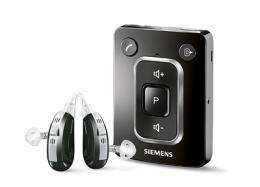Small remote control for hearing aids with bluetooth

A tiny remote control now enables people who wear Siemens hearing aids to transmit audio signals from a television, phone, or MP3 player directly to their hearing devices. They hear the sound much more clearly because the volume is adjusted by means of the remote control and background noises remain unamplified. Siemens introduced he first device of this kind, "TEK," in 2009, and now a smaller version, the "miniTEK," will soon be available. It’s about the size of a matchbox, weighs only 55 grams, and features an attractive design, so it can be worn openly.
Most people with impaired hearing want a solution that can be used discreetly. They wear small hearing aids that fit inside the ear and adjust them inconspicuously with a remote control. The miniTEK and TEK remote control devices offer yet another function: They can connect hearing aids with nearly all entertainment and communication devices. They receive the signals via Bluetooth or a cable and transmit them to the hearing devices. Directional microphones in the hearing aids continue to send ambient signals from the immediate surroundings to the person wearing the hearing aid, enabling him or her to have a conversation during a TV show, for instance. There are special radio adapters for phones or televisions not equipped with Bluetooth. The remote control routes incoming calls directly to the hearing aid. As soon as the user begins the conversation, the transmission of sound from other devices stops. The hearing aid wearer takes part in the telephone call by speaking into the remote control’s microphone.
The remote controls, which are equipped with e2e wireless 2.0, the Siemens wireless technology that suppresses ambient noise, send all audio signals in stereo to both hearing aids. During phone calls in particular, users can understand the person they’re talking to much more clearly if they can hear with both ears. Special radio technologies were developed for the audio transmission to the hearing aids, ensuring that good sound quality is provided by even the tiniest hearing devices, which can accommodate only miniature receivers. The miniTEK can also link hearing aids to audio systems for the hearing-impaired. For example, schools have frequency modulation systems that use microphones to pick up the voices of the teachers and pupils and transmit them to receivers for hearing devices. In many movie theaters and event rooms, induction loops are installed beneath certain spaces. The loops’ signals are registered by a special receiver — and now they can also be picked up by the universal remote control.















